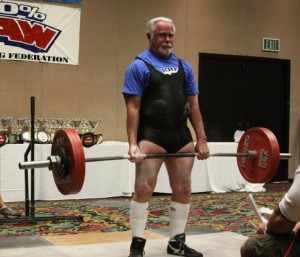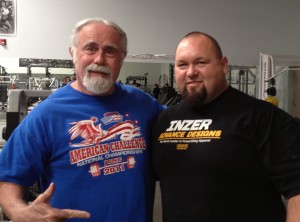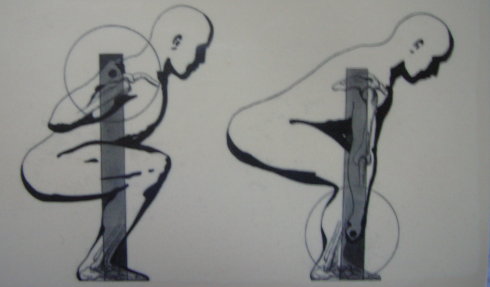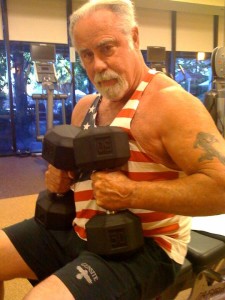How Often Should an Athlete See a Physical Therapist Before Playing Again
Gene Lawrence is a badass. He's a 74 year former powerlifter who has set tons of records in his sport. He didn't first grooming for powerlifting until he was 69. Last yr, he squatted 225, benched 260, and deadlifted 365, all raw. Last year he also tore his left rectus femoris falling downward in his driveway.

Cistron Lawrence
The doctor who performed his surgery told him he'd never squat again. His physical therapist told him the aforementioned. I knew better. I told Gene that inside a twelvemonth he'd probably be squatting his all-time all-time.
As a lifter, I've heard many stories of doctors (and sometimes physical therapists) informing lifters that their careers were finished or that they'd never be able to perform a certain lift ever again. Rarely is this advice appropriate.
Doctors and physical therapists are overly cautious due to liability issues. Their primary concern isn't almost how passionate you are for powerlifting or whatever other sport, it'due south near keeping you injury-free then that they don't go sued. And the best communication to keep somebody injury-free is to tell them non to lift heavy anymore.
However, numerous powerlifters over the years have come dorsum post-obit "career-ending injuries" to ready all-time PR'southward. Donnie Thompson is the only homo to total iii,000 lbs (1,265 lb squat, 950 lb demote, 785 lb deadlift). Many people don't know this, merely several years back Donnie suffered a horrendous dorsum injury and herniated three discs. He could barely walk, but he got out of bed and rehabbed himself every day. Inside 3 months he was back to heavy squatting and setting PR's. Got that? Setting personal records three months following an injury that herniated 3 discs!

This is Gene Standing Next to Donnie "Mr. 3000" Thompson
Following his rectus femoris repair surgery, Factor spent approximately 4 months with his concrete therapist, strengthening his quads and hips and regaining flexibility. After that, he returned to training with Charles Staley and me. Immediately, Charles and I had him performing tons of bodyweight hip thrusts and dorsum extensions to strengthen his posterior chain. We besides started him off on deadlifts. For two weeks information technology was rack pulls with calorie-free weight, and from and so on it'due south been from the floor. After a month, nosotros implemented bodyweight box squats. Two weeks after we had him performing goblet squats. Ii weeks afterwards came the barbell for squats.
In simply iv months of grooming with usa (and 4 months with the concrete therapist before that), Gene has recently squatted 215 lbs (20 lbs off of his all-time all-time), benched 258 lbs (iii lbs off of his all-time best), and deadlifted 330 lbs (35 lbs off of his all-time best at this weight). He'll shortly beat his squat record, just as I predicted. It's not easy returning from a surgery when y'all're 74 years old, but Gene may soon offset setting PR's due to the hard work and consistency he'due south put forth (Charles and I put him on a very regimented schedule).
Hither's what Factor's doctor and physical therapist failed to understand. Powerlifting is what makes Gene tick. It gives him strength, courage, and zeal in life. Gene'south abode gym is his pride and joy – it houses his hundreds of powerlifting trophies and plaques. Setting PR's gives him a reason to get up and train. It's in his claret. If you're a fellow lifter, you get it.
What if Gene had listened to his surgeon and PT? He'd probably have quit lifting, which would have negatively impacted his physical health and devastated his psychological well-existence.
If y'all suffer a serious musculoskeletal or soft-tissue injury, here'south what you should do: 1) Never rush the healing of an injury, 2) Embark upon a gradual, progressive rehabilitation program, and 3) Observe a doctor and physical therapist who empathize force & conditioning (there are indeed enough of great doctors and PT'south out there who also empathize Due south&C – these are the types I gravitate toward). Here'southward what you lot should non do: i) Solely listen to the advice of one md or one physical therapist, and two) Surrender on a sport or activeness before the rehab process has terminated. Nobody tin can know for sure how an individual will bounce dorsum following an injury.
Probably xc percent of doctors don't even lift. The majority don't understand strength training, the mental attitude required to be consistent in the gym, and the pride that accompanies weight room forcefulness. Due to their ignorance and fright of heavy strength training, they often utter ridiculous advice.
For example, doctors will usually tell you to cease lifting weights at the slightest sign of danger. Elbow hurts? Don't lift. Articulatio genus hurts? Don't elevator. Back hurts? Don't lift. Why can't you simply work around the problem? If your knee hurts yous tin can still likely perform weighted back extensions and proceed your posterior chain strong. If your elbow hurts you can yet train legs, core, and some upper trunk muscles. If your back hurts you can still perform single leg exercises and certain upper body exercises. There may be times where information technology's wise to completely avoid strength training, merely this is far more rare than what the doctors tell you lot, and a savvy lifter can e'er piece of work effectually an injury.
Moreover, the vast bulk of doctors and PT'south don't adequately comprehend biomechanics. In our Hip Extension Torque product, Chris and I teach readers how to calculate estimations of torque loading during squats, deadlifts, and other hip extension exercises. I believe that this is a skill that many physical therapists and orthopedic doctors would benefit from – it'southward definitely improved my skills as a personal trainer.

I can't tell you how many times I've trained a client whose doctor or PT informed them that they weren't allowed to perform an do such as a squat or a deadlift, only to find out that they were prescribing an exercise that put simply as much torque loading (or more than) on the joint in question equally the exercise they condemned. Upon inquiry, I discover that the doctor or PT did not examine the client's form in order to accomplish his determination; he just offered a blanket statement to cover his donkey.
Another mutual fallacy I run across with doctors – they'll frequently tell sure clients (let'south say a pregnant lady a back surgery recipient) that they're never to lift annihilation greater than a sure weight, for example 30 pounds. All the same, biomechanics determines the loading on different parts of the body; the interplay between the torso position, posture, load, gravity, and inertia need to be considered. A 30-lb kettlebell deadlift positioned direct underneath the middle of mass and lifted with proper course with neutral spinal alignment volition create far less spinal loading than lifting a 30-lb oddly shaped object positioned out in front of the lifter with a twisted set-up. Contorted body weight exercises can be more than harmful for the spine than 135 pound barbell exercises performed with perfect grade. Never is a very strong word. With proper progressive grooming and excellent form, people can usually build themselves up to be quite strong. Information technology would be far more fruitful to teach proper mechanics than to place a limit on loading and thereby instilling a lifelong fearfulness of strength training. Nocebo effects are unnecessary and counterproductive.
The squat is well-tolerated if you lot understand progression-regression continuums. If you start at the appropriate level and perform the move properly past sitting dorsum and ensuring that the knees rail over the feet, then there's no reason to worry. You tin start with high box squats and work your fashion down in ROM, then add together load in the goblet position. People have to squat in their every day lives, so there's no avoiding the movement design. You lot tin can either pretend the squat doesn't be, or you lot can take the time to brand certain the individual is squatting correctly; distributing the load properly to the hips in order to spare the knees.
Many lifters with articulatio genus problems shouldn't avoid squats altogether; they should larn how to squat properly with low load joint-friendly squatting variations. If volume, intensity, and frequency are kept depression, these drills are usually therapeutic and prevent future injury.
Lifters with dorsum bug shouldn't automatically avoid hip-hinging. They should learn how to swivel at the hips while preventing excessive motility in the spine and develop their gluteals. Rack pulls, deadlifts, trap bar deadlifts, kettlebell deadlifts, kettlebell swings, 45 degree hypers, dorsum extensions, and even bodyweight reverse hypers are all good choices as long every bit proper course is utilized. Many individuals exercise non keep a relatively neutral spine during many of these movements considering they compensate for weak glutes by utilizing excessive spinal move. If these individuals never master hip hinging mechanics, how will their form wait when they pick things up off the ground or perform 1000 work? Again, the solution isn't to avoid the movements, information technology'south to teach and ingrain proper mechanics.
There are indeed plenty of situations where certain individuals would be better off avoiding heavy loading with certain exercises. For case, not everyone is well-suited for squatting and deadlifting. Just this doesn't hateful that they couldn't include goblet squats and dynamic attempt deadlifts into their warm-ups then their squat and hip-swivel form remains solid throughout life. But these same folks can notice other lifts that they tolerate well, for example Bulgarian split up squats, hip thrusts, and Russian leg curls, and they tin build up incredible size and forcefulness through these lifts.
It is not my intention to bash all doctors and physical therapists. I'thou friends with plenty of world-class docs and PT's who possess incredible knowledge of Due south&C. But merely equally with any profession, in that location's a huge gap between the pinnacle tier and the average doc or PT when it comes to S&C noesis. The aforementioned goes for strength coaches and personal trainers – at that place'southward a huge gap between the top guys in the field and the rookie globo gym employees.
Luckily, Gene has 2 competent strength coach friends (Charles and me) who know what makes him tick and helped him formulate a programme of action. Final weekend, Factor competed in a PL contest and met a fellow 91 yr old powerlifter who inspired him. That's how I desire to be – pullin' heavy deads til the day I die. Proceed doing your thing Gene!

Never Give Up Gene!
chamberlaincoth1990.blogspot.com
Source: https://bretcontreras.com/youll-never-squat-again-why-physical-therapists-and-doctors-should-learn-some-biomechanics/
0 Response to "How Often Should an Athlete See a Physical Therapist Before Playing Again"
Post a Comment